A CARNIVAL OF SPIES IN VENICE
 LEO COLOVINI ALEX RANDOLPH
LEO COLOVINI ALEX RANDOLPH

 LEO COLOVINI ALEX RANDOLPH
LEO COLOVINI ALEX RANDOLPH
CARNIVAL IN VENICE . The night is filled with cheerful jubilation, wild rejoicing, singing, laughter, and welldisguised, costumed characters scurrying through narrow alleyways.
Intermingled with the crowd in this festive atmosphere are four special characters, true masters of deception. They are capable of disguising themselves to become unrecognizable, as they sneak through the night on their secret missions.
These four masters of disguise (and one of them is YOU!) are:
Lord Fiddlebottom was already in the Secret Service back when the Service was not at all secret. A dignified character, he is a man of inestimable wealth who hobnobs with all European nobility. He arrived in Venice on board his luxury yacht, Mata Hari II. However, the long years of leading a questionable double-life are beginning to take their effect. This can be seen by, among other things, the constant twitch of his right eye.


Colonel Bubble has been Lord Fiddlebottom’s right hand for years. He was recruited immediately upon leaving the army, where he had achieved great recognition for founding the Royal Balloon Brigade. People say he is unshakable and, even when faced with the greatest danger, he is so cool he is visibly freezing. In agent circles, he is known for his quick wit and for the peculiar habit of tugging on his left earlobe
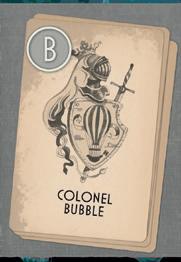
Agent X is extremely cunning, exceedingly furtive and exquisitely wicked. Nobody knows the details of his dark past, but, at the moment, he is said to be visiting Venice. He is a consummate professional, insusceptible to influence, and absolutely ruthless. His appearance is so bland that his contour melts if he stands in front of a colorless wall. He would be a perfect agent were it not for his compulsive frowning.
Madame Zsa Zsa claims to have been a celebrated dancer in her younger years. In reality, however, she performed as a contortionist, which may explain her twisted personality. She is also said to have been part of some questionable business deals in which the local authorities looked the other way. In some circles, she is well known a spy and, currently, cooperating with the notorious Agent X. She considers herself so vastly superior she often condescendingly turns up her nose at other people.
And then there is a fifth character of “the game,” the nosy Ambassador. He is constantly friendly, agreeably ineffectual, and ever-present at parties. He loves to catch bits and pieces of conversation, which he carefully jots down and stores in the safe at the embassy — right next to the super-secret mega-list (a microfilm copy of which he inexplicably always carries around in his vest pocket).
INKOGNITO can be played by 3-5 players.

The goal of each agent is to complete a mission, together with his or her partner. At the beginning of the game, players don’t know which mission they must fulfill.

In the standard 4-player game, each player guides one of four secret agents. The four characters are allied in pairs: Lord Fiddlebottom and Colonel Bubble are always partnered against Agent X and Madame Zsa Zsa
Each of the four agents is represented by one of four different figures, with different builds: tall, short, fat, thin. Only one of them represents the actual character controlled by a player. The other three figures represent spies which are friendly to him and that are trying to confuse the opposition.
In their turn, each player shakes the Phantom of Prophecy randomizer to determine his three available actions. For example, moving on a land route or a sea route. The player moves his figures, trying to reach spaces already occupied by the other players’ figures or the Ambassador.
When figures are in the same space, the current player gets the right to “ask questions,” and inspect some of the cards of that player. By deduction and a logical process of elimination, he can draw conclusions as to the identity and intentions of the other players.

The first goal of every agent is to discover which of the other players is their partner. This partner has the other half of the “code” indicating their secret mission.
After discovering (or thinking they have discovered) the real identity of the other players, an agent must trade his secret mission card with their ally. This will reveal the final mission and what must be done to complete it.
If either agent in a team completes the mission, both he and his partner win the game.
There is another character with an important role in the game; the Ambassador. He can be used to get clearer information about the other characters. Everyone wants to meet him, because he is well-informed and can be useful to accomplish your purposes, but he can also help your rivals, so do everything you can to keep him far from them.
A 3-players variant, where one of the players is alone, without an ally. A 5-players variant, where the fifth player controls the Ambassador. His final goal is to discover the truth about the four characters.


need intuition, cunning and quick thinking to solve the intrigue
complete their mission to win the game. No one is safe in INKOGNITO … are you ready to accept the challenge?

In INKOGNITO every secret agent has four possible physical builds, represented by four different figures in the same color.
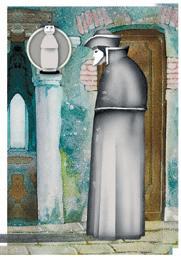
During the game, players ask many questions to gather information about the other characters. The note sheets (in the notepad) help players take note of the answers.











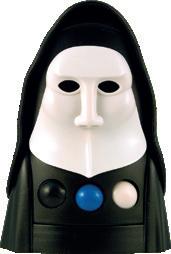
This special character knows something about everybody and he shares this information to anyone who asks him for a “private meeting.” In the 5-players game variant (see page 10), he assumes a more active role and is controlled by one of the players.
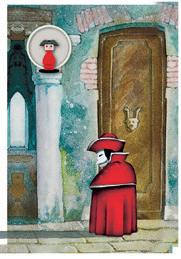



This special randomizer indicates the moves available to the players. Every colored ball provides a different movement action to the player in his turn.
These cards (4 color sets of 8 cards each) are used by players to answer the questions of the other players about identity and physical build of their character.

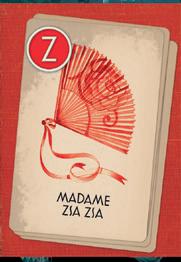
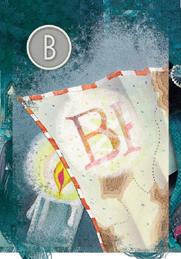
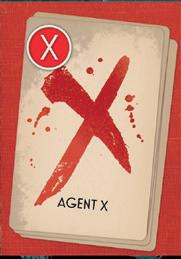





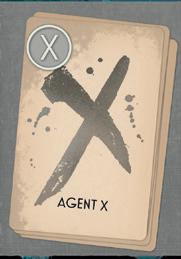
These special screens allow the players to keep all their information secret during the investigation: their cards and the note sheet with the info gathered during the game. They also show the missions that the players must achieve in order to win.

These cards are randomly distributed to every player to determine their real identity, build, and mission. Players keep them behind their passports, hidden from the other players.
Before playing the game for the first time, assemble the playing figures and the Phantom of the Prophecy.
Press the front and back half of each playing piece of the same size and color together, after placing them over the knob on the stand (see Fig. 1). Then affix the mask and hat.
Simply press the front and back halves of the figure together (see Fig. 2).
Press part A and part B together (see Fig. 3) and push it into part C. Drop the ten colored balls into the opening in part A and then press the mask into position over the hole.

The following rules are used in a normal 4-player game.
See page 10 for the changes to setup when playing with 3 players or playing with 5 players.
Place the Phantom of Prophecy in the lagoon area in the upper left-hand corner of the game board.

Place the Ambassador on the black circle marked with the Ambassador figure. This is the Embassy.
Each player chooses a color and takes a complete set of components of this color: 4 figures, 8 colored cards and 1 passport.
Four of the colored cards are identity cards — one for each of the different characters in the game.
The other four cards are build cards corresponding to the figures — one for each of the four build types a character can have: tall, short, fat, thin.
Place the figures on the four spaces of your color.
Take a note sheet and write the names and colors of the other players on the leftmost column, in the first three rows. The fourth row is used to note of the information you show to the other players.
Bend the passport, and place it in front of you to form a screen behind which you can fill out your note sheet. On the interior part of every passport is the list of secret missions.
During the course of the game, players will discover which mission they need to fulfill.
Divide the 12 grey secret cards in three groups (identity, build, and mission). One player takes the four identity cards, shuffles them, and deals one to each player (including himself) facedown, unseen.
The next player deals the four build cards to everyone, and the third player deals the mission cards. Each player then looks at the cards received, which reveals the following information:
1 identity card, telling him which of the 4 agents he represents.
1 build card, from which he learns the true build of his agent (the other figures of your color represent friendly spies pretending to be the agent).
1 mission card, which, when joined with the mission card of the currently unknown partner, indicates how to win the game.
Do not let any other player see these cards, even unintentionally. All of this information has to be kept secret until you give it out when meeting other characters.
Randomly determine the starting player. After the first player takes his turn, the player to his left goes next, and so on.
During his turn, each player completes the following steps in sequence:
1. Movement
On your turn, shake the Phantom of Prophecy vigorously, then set it down firmly on the table. The three colored balls that appear below the mask determine your available three movement actions.
You may move one of your own figures one space on a land route (orange lines).
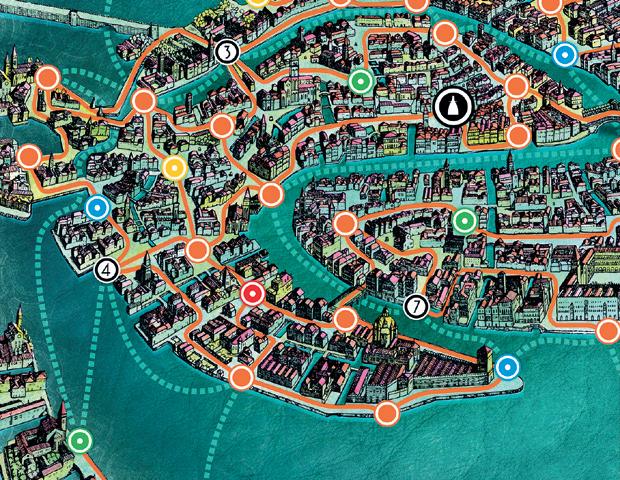

You may move one of your own figures one space on a water route (light blue dashed lines).
You may move one of your own figures one space on land or water.
You may move one opponent’s figure one space on land or water.
You may move the Ambassador figure one space on land or water.
Note: It is not mandatory to use all three possible movement actions.
Once the movement is complete, proceed to Meeting Characters and Asking Questions (see page 7).
The orange, light blue, and white balls may be assigned to move your own figures any way you wish.
For example, you may use all of them on one of your figures, moving it three times; or move three different figures once; or move one figure two times and another figure only one time.
The following movements are allowed when moving your figures:
You may move your figures onto a space occupied by another player’s figures.
You may move one of your figures onto the space occupied by the Ambassador figure.
You may move your figures through other figures without stopping on their space.
You must also observe the following restrictions:
You are not allowed to end your move on the space occupied by another of your own figures.
You are not allowed to end your move with more than one of your figures occupying the same space of more than one of an opponent’s figures. You are allowed to meet figures of several players, but not more than one figure of the same player.
Leo is the green player. He shakes the Phantom of Prophecy and rolls an orange, blue, and white ball.
He uses the orange ball to move one of his figures closer to the Embassy (1).
He uses the blue ball to move another figure across the channel to space #4 (2).
Finally, he uses the white ball as a land movement to continue moving this figure to the blue space, so that he can ask questions to the blue player (3).
When you get a black colored ball, you can move the Ambassador figure one space, on land or water. You can move it to a space occupied by one of your figures, to ask him questions, but you cannot move the Ambassador to a space occupied by the figure of another player.
When you get a purple colored ball, you can move an opponent’s figure one space, on land or water. You can move the opponent’s figure onto the space of one of your own figures (to obtain information on that player), but you cannot move the opponent’s figure onto a space occupied by a figure of another player or the Ambassador.
You must reach spaces that are occupied by other agents, or by the Ambassador, to collect information.
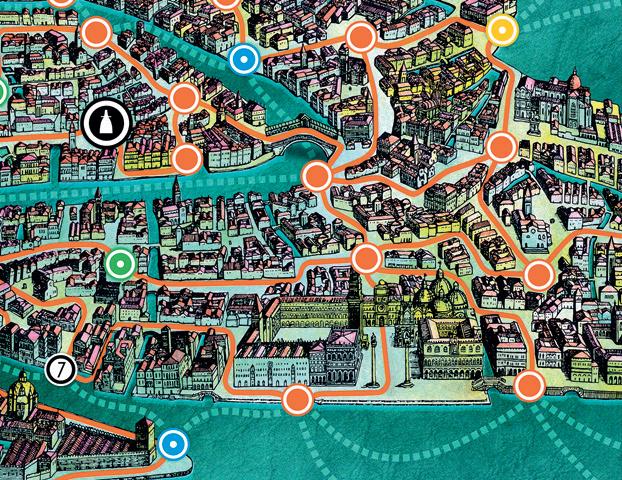
There are two ways to meet another figure:
a. Move one of your figures to the space occupied by the other figure.
b. Move the other figure to a space occupied by one of your figures. This is possible, if you rolled a black or purple ball with the Phantom of Prophecy.
When you meet another figure, you may ask questions and then send the figure you met to another space (see Expulsion, below) of your choice.
Instead of asking a question, you may move your own figure one more space (either on land or water).
However, when doing so, you may not move to a space occupied by another figure.
This is especially useful toward the end of the game, when you might find that you don’t need additional information.
If you end a movement on a space with another player’s figure, you are entitled to see three of that player’s cards.
Choose one of the following options when asking a question:
1. You may ask the other player about his identity. He has to show you (hidden from the other players) two of his identity cards and one of his build cards.
At least one of these three cards must be true.
2. You may ask the other player about his build type. He has to show you (hidden from the other players) two of his build cards and one of his identity cards.

At least one of these three cards must be true.
Remember: On your turn, your different figures are allowed to meet figures of several players, but not more than one figure of the same player.
Michael is the red player. He shakes the Phantom of Prophecy and rolls a black, purple, and orange ball.
He uses the orange ball to move one of his figures on land (1).
He uses the purple ball to force the yellow figure to move onto the same space (2), so he can ask questions to the yellow player.
Finally, he uses the black ball to move the Ambassador (3).
If you end a movement on a space with the Ambassador, you may request to see either two identity cards or two build cards of any player of your choice.
One of the cards must be true
When you receive information from your opponents, you will need to write it down on your note sheet to remember it later in the game.
Every time you see another player’s cards, you can record the information on your note sheet, in the appropriate row for that player.

After a series of questions, with the help of these notes, you will start to figure out the real identity and build of the other players.
In addition, we suggest you write down (using a different symbol and writing on the fourth row your sheet) which of your own cards you have shown to the other players, so you avoid showing the same cards twice and paying the penalty for such a mistake.
Michael is Lord Fiddlebottom. He moves one of his figures onto a space occupied by one of Leo’s figures, and asks him about his build type.
Leo shows Michael his “Short” and “Tall” build cards and the identity card “Colonel Bubble”. Michael writes down on his note sheet the cards that Leo has shown him, and Leo writes down on his note sheet which cards he has shown Michael.
In the next round, one of Michael’s figures meets the Ambassador. Using the Ambassador’s ability, Michael asks Leo about his identity.
Leo shows him “Lord Fiddlebottom” and “Agent X.” But Michael is Lord Fiddlebottom! Since one of the two cards must be true, Michael can now figure out that Leo is Agent X.
At the same time, Michael can now deduce that Leo, as Agent X, must be either “Short” or “Tall,” since at least one card from the first questioning must be true. Michael can note these deductions on his sheet and continue in his hunt for information.
If you mistakenly show the same three card set to the same player a second time and he points this out to you, you must now show him one card less, and at least one of the cards must be true.
If you show the same three card set to the same player for a third time, as a penalty you must show him one true card.
If a player disputes or argues that he has already shown you the same cards for a second (or third) time, you have to prove the contrary by using your notes. (Don’t cheat!)
If you cannot do that, you must be satisfied with the cards shown.
In addition, when you show your cards to another player whose figure is questioning the Ambassador, you are not allowed to show a pair of cards that are the same as those you have shown to that player before, or that are part of a combination of three cards you have shown to that player before.
If you mistakenly do this, as a penalty, you must show him just one true card.
In previous questioning, Leo had already shown Michael the cards “Short,” “Tall,” and “Colonel Bubble.” Now, Michael meets the Ambassador and asks Leo (again) about his build type.
Leo again shows the build cards “Short” and “Tall”. Michael points out that Leo since Leo had already has shown him these two cards as part of a set, Leo must now show Michael the one true build card.
After you have met the figure of another player and questioned him, you must send this figure to any unnumbered and unoccupied space on the board.
After you have met the Ambassador, you must send him to the Embassy space, if unoccupied, or to any unoccupied colored space.
To win the game, you will need to identify your partner, uncover your mission, and complete it.
It is important to remember that you are not allowed to show the same set of three cards to the same player more than once
In INKOGNITO it is very important to hide your identity from other players, but it is even more important, and in fact, necessary to win, to find out who your partner is and to reveal yourself to him.
During the game, after you have received answers to your questions and you have drawn your conclusions, you will begin to figure out who the other players are. Eventually you will find out which one is your partner.
To reveal your true character to him, there are two basic methods. First, you could show him the unusual trait of the character you are playing (e.g., twitch your right eye if you are Lord Fiddlebottom). Second, if you are absolutely positive about his identity, the next chance you have to show him cards, reveal one or more of your grey secret cards instead of colored cards.
If you are sure about who is your partner, it is especially important to show him your mission card to reveal your common mission and try to accomplish it. Try to meet one of his figures as soon as possible, so you can see his half of the combination and know your mission as well. But — be sure you are not mistaken about who is your real partner!
Note: If you show a mission card, it does not fulfill the requirement to show one true card. At least one more card must also be true.
While you are searching for your partner, you can try to confuse your opponents at the same time.
For example, you can use the traits and mannerisms of the four characters to send real or fake messages to the other players. It is only mandatory to be honest when showing cards — at least one card must always be true. Other than that, you may cause confusion as much as you want with words and mannerisms. You are a secret agent, almost everything is allowed!
You can also trick an opponent by showing him your secret mission card, so he falsely believes you are his partner. And certainly, many more nasty tricks will occur to you in the merciless battle of agents!
Another way to set obstacles for your opponents is by moving their figures using the purple ball and the Expulsion rule — you can draw them closer to your figures or move them away from the Ambassador. Try to make completing the mission easier for your team and more difficult for your opponents. Mixing these actions with the Phantom of Prophecy outcomes will provide you with a lot of strategies to achieve your goals and slow down your enemies.
As soon as you have seen your partner’s mission card, you can decode the common secret mission. Look at the list of missions in your passport and find the line that shows both your codeword and your partner’s codeword in the right sequence. Now you know what you have to do to win!
You may only complete a mission in your turn.
When a mission indicates the name of a specific character, the figure with the correct build of that character must be involved. This applies both if the named character is the one to be moved (for example, “Move Lord Fiddlebottom to space 5”), or if the named character is the target of the mission (for example, “Land any piece on Agent X”).
When a mission indicates “any piece” (for example “Land any piece on the Ambassador”), you may use any of the eight game pieces in your team of agents to complete the mission.
You are Lord Fiddlebottom and have the “B” mission card. Your partner, Colonel Bubble, has the “D” card. Cross-referencing this information on the passport, your common mission is:

“To Colonel Bubble: They know you are Zero-Zero-One. A balloon will pick you up at 11 p.m. at the old Arsenal. (Colonel Bubble must get to space #1.)”
For the mission to be fulfilled, the actual figure of Colonel Bubble (with the proper build) must be standing on the space marked #1.
You can also conclude that Madame Zsa Zsa and Agent X either have the mission A-C or mission C-A. That means you must rigorously prevent any opponent’s figure from approaching Colonel Bubble.
The team that is the first to fulfill its common mission wins. This happens when the appropriate condition on the passport is met during the turn of one of the two partners.
Victory is announced by saying “Mission Accomplished!” with a grandiose handshake between the two partners.
However, at this point it must be determined if you are right about who are partners and what mission is required. If you are wrong, then the opposing team win!
But, what happens, for example, if you (as Lord Fiddlebottom) want to shake hands with a player and that player refuses? If that player is your actual partner (Colonel Bubble), then it is hard luck — the opposing team wins. If the refusing player is not your real partner (e.g., Agent X), then your actual partner is unlucky as well. In this case, the other team (Agent X and Madame Zsa Zsa) wins.
The police have put out a press release stating they are holding a spy under arrest. According to police, the agent is being interrogated at a secret place, and it is still too early to say anything about his identity.
With the shocking news the Ambassador declares, “I will leave no stone unturned till we have found the source of the leak...”
INKOGNITO is designed for 4 players, but the 3-player variant is devilishly fun, too. One of the agents’ partner has been arrested. If it is your partner, you cannot achieve your mission, so you must flee the city before it’s too late! Otherwise, you must complete your mission before the police get on your tracks, too…
The figures, cards, and passport of one color are removed from the game.

To begin, the cards are distributed as in the 4-player game. However, one set of cards is put aside. The game proceeds as usual, until one player either discovers that one of the other players is his partner or that he is on his own.
If you have a partner, you complete the game as in the 4-player version, with the following exception:
If your mission refers to the missing character, read the information as if it indicates the active player instead.
The Ambassador is concerned about what all the spies in Venice are up to. Are their preparing some criminal misdeed?
He decides he must unmask them and reveal their identity to the police before they may complete their nefarious purpose… All the while pretending he is helping them!
In this new edition of INKOGNITO , one of the main innovations is the 5-player variant, presented here.
The game is similar to the 4-player game with the important difference that the Ambassador is played by the 5th player.
The Ambassador player does not use the Phantom of Prophecy. During his turn, the Ambassador player may move his figure once or twice, using any land or sea route.
When the Ambassador moves into the space with another player’s figure, he may ask the player to see two identity cards or two build cards. One of the two cards must be true. Then, he sends the other player’s figure to any unnumbered and unoccupied space on the board.
During the other players’ turn, the black ball has the normal effect. The other players may move the Ambassador figure one space on land or water.
The mission for the Madame Zsa Zsa and Agent X team is to move one of their figures onto a space with Colonel Bubble (mission C-A).
However, Colonel Bubble is not in play, so they must move one of their figures to the space with Lord Fiddlebottom.
If you are playing without a partner, then your mission is to leave Venice by the quickest route, reaching the space marked with a small running figure on your passport.
Lord Fiddlebottom must get to space #5.
Colonel Bubble must get to space #1.
Madame Zsa Zsa must get to space #4.
Agent X must get to space #6.
When an agent player uses the Ambassador figure to ask information from another agent player, that player must pass the chosen cards to the Ambassador’s player first. The Ambassador player looks at the cards, and then passes them to the player that asked the question. In this way, the Ambassador collects information about the other players every time his figure is used, not only during his own turn.
The goal of the Ambassador player is to know all the identities and build types of the other four players before any team completes its mission.
When he is sure he has all of the information, he declares “I know who you are…” and records the identities and builds of each player on his note sheet. The game continues normally and, when one of the two spy teams declares “Mission Accomplished!” the Ambassador player shows his note sheet. If he correctly announces the identities and the build types of the four players, he wins the game; otherwise follow the usual 4-player rules to determine who has won the game.
In a 5-players’game, if your mission requires you to “Move the Ambassador to” a location, the mission becomes “Move one of your agents to…” that location. You may fulfill the mission using either figure with the correct build from your team.

